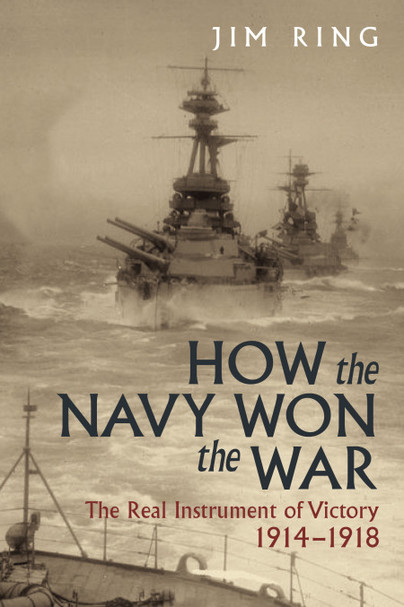
How the Navy Won the War: The Real Instrument of Victory 1914-1918. By Jim Ring. Seaforth Publishing, Barnsley 2018.
Reviewed by David Hobbs
JIM RING’s book is an expression of his own reasoned opinion and analysis, gained after reading widely about the Great War, rather than a straightforward history of events. As such it is fresh and appealing; there are no source notes but he does quote extensively from a wide range of volumes which are listed in his seven-page select bibliography.
These include titles by Winston Churchill, John Buchan, Erskine Childers, John Keegan and David Stevenson and many others. Ring views the war holistically, balancing the effects of battles on land and sea with the effects of the blockade as it gradually impacted on the German population and its ability to wage total war. He looks at the conflict through fourteen facets, each illustrating the underlying importance of sea power. It was British sea power that cut German imports by half at the outset of the war, sustained the BEF in France together with both Imperial and Allied forces in every other area of conflict across the globe. The Royal Navy enabled the US Army to be transported to Europe and coal to be exported to the British Empire’s allies to sustain their industries.
Ring’s reflections on the opening days of the war are among his most thought-provoking as he describes how, even on 5 August 1914, it was by no means certain that the BEF should be sent to France or, if it was, what immediate purpose it should fulfil. Kitchener’s immediate demand for a vast expansion of the Army to fight a continental war on a scale comparable with France and Germany was accepted by the British Government without discussion although it had no idea what such an army was expected to achieve or when it might do so. The failure of battles at Loos, the Some and Passchendaele to achieve the expected break-through is balanced with the argument that if the British Empire had not deployed a large Army in Flanders by 1916 the French may well have been knocked out of the war before the noose of the British blockade against Germany had fully tightened. The tragedy of the Gallipoli campaign, as a bright idea that had been given insufficient forethought or planning, has its own chapter and the British failure to carry out amphibious landings behind the German Western Front is a theme that recurs throughout the book.
Jim Ring has put forward his own views, derived from a deep study into the opinions of others as expressed in their own books on the Great War. You might not agree with him in every detail but their expression in this book certainly stimulates the readers’ thought processes into considering the underlying reasons for the eventual Allied victory. It counters the myth that the war was fought almost exclusively in the trenches of Flanders while battleships lay idly at their moorings in Scapa Flow.
In summary this is a slightly unusual treatment of the subject but one that stimulates the reader to think for himself about cause and effect. The politicians’ lack of an initial war plan, summed up in a quotation from Erskine Childers’ book The Riddle of the Sands, ‘We have no theory or doctrine of national defence and no competent authorities whose business it is to give us one’ is a chilling reminder that the possession of armed forces, even very large ones, is not in itself enough to guarantee success. Ring gives the impression that the British Government, responsible for the most powerful navy the world had ever known, had forgotten about the implementation of sea power and, having no pre-conceived idea about how to fight Germany, drifted into an entirely new strategy structured around a vast but untrained volunteer Army fighting a continental war. What happened a century ago still has obvious resonance today if, as happened in August 1914, our peaceful world is confronted with unexpected events that do not give us the luxury of time to think about what to do. This is an unusual and thought-provoking book that stimulates the reader to draw his own conclusions about the real instrument of victory in 1918. Those who wish to study the author’s background research more deeply can select their own further reading from the bibliography so potential readers should not be deterred by the lack of source notes.
This is a book that cuts through the myths and I recommend it to a wide readership, not only those with an interest in the Great War but to those involved in the formulation of an Australian defence policy and its implementation today.



